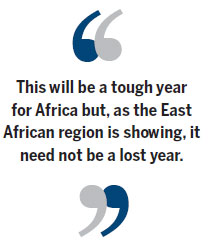East Africa shows the way

As commodity prices fall, outlook for continent's growth more clouded than in any year this century
The decline in commodity prices in the past 18 months has been as much - perhaps more - to do with producers adding too much capacity as it has been because of China entering a lower-GDP growth environment. In the case of China, the new character of its growth is less resource intensive and more oriented toward the expansion of the consumer side of the economy.
If China can in any way be "blamed" for what has happened to commodity prices in 2014 and 2015, it is only in the sense that its physical demand for commodities has not grown at a pace sufficient to absorb all the new supply coming on stream from commodity exporters all over the world, from iron ore from Australia to cooper from Zambia.

Africa has generally been negatively impacted by this combination of significant new supply and the maturing nature of Chinese demand with the result that the continent's terms of trade have materially suffered: the prices of Africa's commodity exports have fallen faster than those of its manufactured goods imports. Consequently, the 2016 outlook for Africa first and foremost involves adapting to a world which is now oversupplied in terms of oil and minerals.
There has been another external factor weighing on Africa's prospects. The yardstick of its external trade remains overwhelmingly the US dollar and this has been strengthening for over two years. Not only has this currency appreciation undermined commodity prices by sucking liquidity out of the global trading arena, it is dragging down overall global growth. The trend looks likely to continue into 2016. This trend might reverse if US GDP growth were to stall, forcing the US Federal Reserve to end this monetary policy tightening.
This combination of lower commodity prices and a decline in US dollar liquidity globally has been negative for Africa's prospects as evidenced by a slowdown in the continent's GDP growth. Even former growth stars like Angola have been impacted.

And there is another headwind that both Africa and China are currently having to battle: deflation. Yes, commodity prices have fallen but so too have prices of most traded manufactured goods, though admittedly not by as much. Deflation weighs on growth wherever it happens but especially so where there is debt to finance. And just as in China, nearly every African nation has since 2000 increased its debt burden, mainly at consumer and government levels, and in some countries at the corporate level, too. Less like China, many African nations also run current account deficits and have increased their external borrowings. Financing these foreign debts in a deflationary world is challenging; financing them when one's currency is depreciating versus the US dollar is even more so.
Against this backdrop, the outlook for Africa's growth prospects in 2016 is probably more clouded than it has been for any year this century. Even so, many positive structural trends remain intact, as do some cyclical ones.
Africa's demographics remain among the most attractive in the world - population pyramids are heavily weighted toward the young "base" and the complications of dealing with an inverted pyramid - a greying workforce and an increasing number of retirees - is far from diminishing Africa's growth prospects.
Although not without its problem countries - notably Burundi and Somalia, although there are a few glimmers of hope emanating from the latter - East Africa appears to be the region making the most economic progress in the African continent as a whole. Part of the reason is that this region's exports are - within Africa - the least geared to oil and minerals. In most cases, the countries of the region are in fact net importers of both; their commodity exports are typically more agricultural in nature and agribusiness export prices have generally performed much better than those of minerals and oil. Indeed, lower oil prices are a windfall for most of the oil-importing countries.

But East Africa's relatively rosy prospects go far deeper than exporting the right - and even importing the right - commodities. Being adjacent to the Indian Ocean and so facing a resurgent Asia is a huge advantage. Furthermore the governments of this region appear prepared to "think outside their country", to envision their place within their wider region and within the shift of the economic center of gravity from West to East, and then cooperate with their neighbors to turn that future vision into a reality. In 2016, expect this foresight to start paying off handsomely and setting this region apart from others in Africa.
Among the examples of this pan-regional approach are the adoption of a Single Tourist Visa by Rwanda, Kenya and Uganda with more neighbors expected to join the program; the implementation - with material support at all levels from China - of an integrated infrastructure program connecting electricity grids, building rail links and pipelines, expanding road networks and developing ports while keeping the needs of landlocked neighbors in mind; the end of cross-border roaming charges for mobile phones under the "One Network Area" and harmonizing voice and data tariffs; allowing the citizens of Kenya, Uganda and Tanzania to work in each other's country without a special work permit; facilitating cross-border electronic money transfers; establishing a free trade area encompassing five countries that subscribes to "Four Freedoms" - the free movement of goods, labor, services and capital; standardizing its SIM card registration process to prevent fraud; and seeking assistance from the IMF on how best to harmonize its tax policies.
This will be a tough year for Africa but, as the East African region is showing, it need not be a lost year. With the continued support of partners, including China, that see the long-term potential of the continent, 2016 could well be a year when those countries with true foresight will make the most progress. And, perhaps surprisingly, the most progress will probably be made by Africa's second-tier nations, not its first-tier ones.
The author is strategist at Investec Asset Management. The views do not necessarily reflect those of China Daily.
(China Daily European Weekly 01/01/2016 page14)
Today's Top News
- New engine powers cargo drone expansion
- China to boost intl cooperation on green tech
- Factory activity sees marginal improvement in November
- Venezuela slams US' 'colonial threat' on its airspace
- Xi: Strengthen cyberspace governance framework
- Takaichi must stop rubbing salt in wounds, retract Taiwan remarks






























